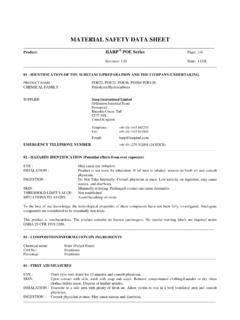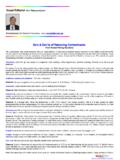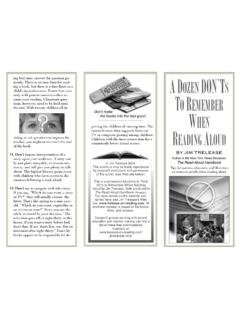Transcription of Do's and Don'ts CO2 in Cylinders Safe Handling and Storage
1 Do's and Don'ts CO2 in Cylinders Safety information for CO2 cylinder users Safe Handling and Storage 1. Carbon dioxide is stored in Cylinders as a compressed Do use Do usegloves gloveswhen when Handling Handling Don't handle Cylinders and valves liquefied gas and any increase in with wet hands. temperature will cause an increase Cylinders and valves. Cylinders and valves. Do Don't drop Cylinders , allow them in pressure. Consequently the Do handle handlecylinders cylinderswith care. with care. pressure in the cylinder is not a Do store Cylinders in a cool place to be struck violently or use them Do store Cylinders in a cool as work supports, etc. reliable indication of the contents. with low level ventilation.
2 Place with low level ventilation. Don't store Cylinders in direct To protect Cylinders against over- Do store Cylinders safely and pressure, they are fitted with Do store Cylinders safely and securely. sunlight, near steam pipes or other bursting discs. These discs are securely. Do carry Cylinders in open vehicles sources of heat. designed to rupture at 190 bar, Don't keep Cylinders in a damp or Do carry Cylinders in open if possible. with an initial loud bang, followed vehicles Do check if possible. that Cylinders are corrosive atmoshphere. by a rushing noise as the cylinder contents empty. correctly labelled before taking Don't carry Cylinders in closed into store. vehicles without adequate 2. The cylinder valve outlet thread ventilation.
3 Is inch major diameter, 14 Don't use Cylinders that have no threads per inch, BS Whitworth label or are incorrectly labelled. form. Female connection should be in accordance with IBS 341: Part 1. outlet connection No. 8. Usage Do fit a pressure regulator to the Don't connect a cylinder directly to 3. A standard (vapour off-take). cylinder discharges gaseous CO2. valve outlet (vapour off-take a low pressure plant Cylinders with a white stripe Cylinders only). Don't use equipment of doubful running along their length are fitted Do use equipment designed for origin or design. with dip-tubes to discharge liquid the duty. Don't connect pressure regulators CO2 (liquid off-take). In both cases, Do use a vaporiser if gas is directly to liquid off-take Cylinders .
4 The valve should be uppermost Don't open valve fully until required from a liquid off-take when discharging CO2. cylinder satisfied that all connections are 4. A single large vapour off-take Do secure cylinder vertically with properly made. cylinder (34kg) can deliver up to valve at top before use. Don't use cylinder valve as a flow Higher flows will cause the Do point valve outlet away from controller. cylinder to become very cold and you before opening valve. Don't seal leaks while equipment is collapse the pressure inside it. Do open valve momentarily before under pressure. High flows can be safely obtained connecting to circuit. Don't use a Stillson wrench on the by using liquid off-take Cylinders together with a suitable vaporiser.
5 Do use the cylinder valve in the valve handwheel or use excessive fully open position force when operating the cylinder 5. As CO2 vapour is heavier than Do close cylinder valve and valve. air it will tend to sink to the lowest depressurise circuit before Don't use Cylinders with faulty level when released to the disconnecting cylinder. valves. atmosphere. Don't store full and empty Do use non-return valves in circuits where there is a possibility of Cylinders together. 6. A safety data sheet is available from Harp International Limited and liquids being returned to the Don't attempt high flow rates from should be obtained before use of cylinder single vapour off-take Cylinders . this product. Do clearly label faulty Cylinders Don't intefere with pressure with fault and return to supplier as regulator or relief device settings.
6 Soon as possible. Don't intefere or make any Emergency Contact: Do return empty Cylinders as soon substitution to the cylinder as possible. bursting disc. +44 (0) 1270 502891 Do use a valve outlet cap to Don't use Cylinders that have no protect the valve threads and commodity label or are incorrectly prevent the outlet becoming labelled. (24 hours). contaminated. Don't take any chances. Do ensure that Cylinders have the correct commodity label before use. Do follow the guidelines.










